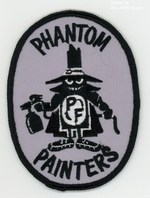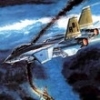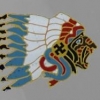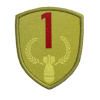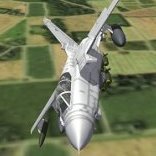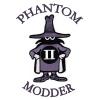Leaderboard
Popular Content
Showing most liked content on 12/19/2023 in all areas
-
8 pointswell, it's not perfect .... the unders could be a little more of that 'cream gray' you see on Phantoms and Thuds....but without a real template I made due with what I gots to work with. I mean, hell, not bad for 8 hours of work ..!!!
-
6 pointsJust before I migrated to Windows 11, of which I'm still experiencing massive 3ds Max issues and falling back to the old development computer, I had a few goodies underway that I need to unload. Much to everyone's surprise, the mystery vehicle has been revealed. And the assigned crew here are not happy about Wrench's rusty van serving American hot dogs. But in secret, some are really starting to enjoy them. Created this just for fun in case you like it. Wrench, I'll PM you with more details and see what other changes you might like. And maybe, just maybe if you sell more dogs you can get this thing a fresh paint job...
-
6 points
-
5 points
-
5 pointsI have been working on this for a long time so it is time to share it with you defiant polite helmets from the 70s to today.
-
4 points
-
4 points
-
3 pointsDassault Mirage F-1AG, JaBoG 31 "Boelcke", Norm 76 Camo, 1976 JaBoG 34 "Allgäu", Norm 83 Camo, 1984 Marinefliegergeschwader 2, Norm 76 Marine Camo, 1978
-
3 pointsI couldn't do that in 8 months without asking for help, and then lying about why I didn't get it done. That's some seriously nice work. However............. There are 2 screws missing on the cockpit canopy rail that just ruins the whole model.... Well, somebody's gotta count them rivets!!!!
-
3 points
-
3 points
-
2 points
-
2 points
-
2 pointsjust so we're clear on what we're seeing, the hovering Huey is a ground object?! mandatory screenie, or Thunder over Italy
-
2 points
-
2 pointsThe biennial USAF World Wide Weapons Meet had began in June 1954 with Air Defense Command and Air Training Command being the sole competitors but by 1956 the meet was expanded to include nine teams representing seven major Air Commands and gaining the (then) unofficial nickname of 'William Tell'. William Tell 1965 was the largest in history with 16 teams and four categories but the demands and distractions of the Vietnam War meant that there was a five-year pause until 1970 when William Tell resumed at Tyndall AFB with twelve teams competing in an expanded competition with three teams in each of the four categories of jets competing at William Tell; the McDonnell F-101B, Convair F-102A, Convair F-106A and the new Saab-Fairchild F-13A with the latter being represented by the 125th FIW (Florida ANG), the 177th FIW (New Jersey ANG) and the 52nd FIW (New York ANG). The competitive flying ran from Monday, October 26th through Friday, October 30, 1970 and the three F-13A teams gained an early lead in the overall competition and the torrential rains in the middle of the competition only seemed to improve their position which ended with the 177th FIW from the New Jersey ANG winning the overall category and the F-13A category whilst the 125th FIW from the Florida ANG scooped the aircrew award and also the aircraft maintenance award with the three F-13A teams filling the top three slots.
-
1 point
Version 1.0.0
253 downloads
SF2 Formosa Straits Terrain Revamp (v.2) by Gepard 10/15/23 *Full 5 Merged Installs Recommended* This terrain mod is designed to REPLACE any and all eariler versions. It also includes any previous updates from long past years. It is designed for use with the SF2-NA environment While the tiling has not been touched, (almost) all the target areas have been revamped, rebuilt or replaced. Several new regions have been added, and many of the other inis have been upgraded (See Notes for more changes). Several items (Ground Objects & Weapons) are supplied; in the Notes section is a list of other items you'll probably want to obtain. Be advised, you will experience longer than usual loading times, due to the weight of objects on the terrain. And yes, you can expect a plethora of 'hidden in the open' Easter Eggs. After all, it's my trademark!! (tm) As always, PLEASE read the install instructions, and the accompaning Notes and Other Nonsense for more details on other needed items. As is reccommended, unzip to an easy to find location, so you can access the readme for it's full instructions. Gepard's original readme is also included, for historical purposes. Good Hunting! Wrench Kevin Stein -
1 pointHi all, I'm working on some .ini tweaks and weapon load-outs (from the B-57B Flight Handbook at Avialogs https://www.avialogs.com/aircraft-m/martin/itemlist/category/1198-b-57-canberra ) for my SF2 Vietnam install, but I've had no luck tracking down a SEA Camo Over Gray skin for the B-57B. Does anyone have such a skin that they'd be willing to share? Minor .ini edits I can do, but skinning is beyond me. Geary was working on a project back in 2018, as per this thread: Here are some images from the interwebs: Any info on these awesome aircraft very much appreciated. Kind Regards, KB
-
1 pointView File Royal Meteors. 1944-1970. Royal Air Force Meteors. Bunch of Meteors for the Royal Air Force and Royal Navy. This mod is not to compete with the previous Meteor mods that I was part of. It is just my, different approach. Basic modding skills are required to run this mod. (copy/paste, mod folder structure, etc.) Install: Copy and paste specific folders into the correct destination. A fake pilot is required to run this mod. Also, the Thirdwire Meteor cockpit is required from the original game. Fuel tanks- not to be afraid. Overwrite or just leave it. 100 gal tank is the original TW tank. You can overwrite or just simply do not copy. 175 gal tank also. Tanks are just ini files. The mod uses tanks that are part of aircraft lod. Yes, again Meteors. But I made this revamp to fix what I wanted to fix for some time already in old models..plus a few new things. So we have 22 different (more or less) aircraft. F Mk.1 - first 12 production Meteors with Welland I engines. Not all served in 616 Sq at the same time. Some were moved to RAE or Gloster Company for further development. F.Mk.3 - first 15 airframes with Welland I engine. F.Mk.3 - equipped with Derwent I engine. F.Mk.4 - High-Speed Record (Basically F.4 with long span wing from F.3 - Or F.3 with long Nacelles - depends on how you look at it - but serial is listed under F.4) - Anyway, bonus aircraft for speed record in 1945 and 1946. F.Mk.4 - fighter jet with Derwent 5 engines. T.Mk.7 - two-seat training jet. F.8 - represented in mod with 3 variants for the game. First with an early canopy hood. Then bubble canopy and the last one with a large bore engine intake...(mostly serials WK and WL...but at some point, you could have large intakes and early canopy...just a matter of when and where) FR.9 - fighter recon version in two variants early and late canopy. PR.10 - photo reconnaissance version NF.11 - radar night /all-weather fighter NF.13 - radar night /all-weather fighter with additional equipment for use in hot/tropical climate NF.12 - radar night /all-weather fighter NF.14 - radar night /all-weather fighter NF.14(trop) radar night /all-weather fighter with additional equipment for use in hot/tropical climates mostly prepared for No 60 Sq. But also served within units stationed in Great Britain. NF(T).14 - training version for Air Navigation Schools - Rebuild from NF.14 - no radar or armament. TT.20 - target tug aircraft with target sleeve for artillery practice (target sleeve is deployed as bomb bay doors - AI will open doors when approaching target). U.15 - target/research drone jet based on F.4 Meteor U.16 - target/research drone jet based on F.8 Meteor T7(TT) - separate version - target tug with target banner. - Should start in the air in single mission editor - while AI is taking off it will lose the banner on an airstrip. Tip... TT.20, U.15, U.16, and T.7(TT) are serving for nation=RAF but privately I have them as RAF-RED for 'training purposes' you can do that too, or screw this at all. Use it for your liking. I do not know how you are going to use those special aircraft...but it is here for general enjoyment. While RAF did not have in mind using Meteors for a ground attack there was a possibility to equip them with non-guided rockets (F.8 and FR9) or bombs (F.4/F.8/FR.9). So you can do it...but I set primary/secondary mission only CAS and armed recon for FR.9...but you can always edit it your way. I fixed data files a little - collision points and hitboxes..as the previous ones were quite weird. But I believe that the flight model could be improved for this aircraft. But this is not my cup of tea nor coffee. All skins are in 4096x4096 format. You can easily resize as needed. Now all Meteors are using the same common color standard. Skins represent all squadrons that operationally used Meteors. Later at some point, after withdrawal many Meteors found some new home as squadron hacks..and could be found everywhere...almost. But those were single examples in specific markings. Those are not included in this mod. I Made a bunch of decals. Some squadrons have special markings on the fin to represent commanding officer aircraft (usually the correct serial number for a specific year), and some do not. Mostly code letter is generic and do not correspond with real code assigned to serial number. But in a few skin sets it is as it should be. You will see. Explore. Also, RAF letters folder should be added to the Decals folder I know it is big but it gives slightly better quality with still small file size All correct serial numbers for every Meteor version. Excluded are numbers that never served within the Royal Air Force or were sold to other countries from RAF inventory. this gives us 2918 individual serial numbers (I believe that is the number never counted what I did). There are many reasons why I have made things in this mod the way they are...versions, skins, and decals. A lot to explain but I doubt anyone wants to read about it anyway. Under no circumstances do not use any part of it with older Meteors done by me and published here in CA. These new ones have some differences in mapping. Some things were changed, some mapping issues and small thingies. So please do not mess up things. Credits. Veltro2k - the original old model of t7 Yours truly - model rework, mambo jumbo like skins, decals, research... No animal was harmed during the creation of this mod. Only Italian coffee was used, mod may contain cookie crumbs and nuts. Seat - all credits to the creator - unfortunately I don't remember who made this seat. I guess the skin was painted by Kulbit. Pilots - RAF pilot by Geezer another one I have no idea / don't remember who did it. All credit to him/her. Weapons RP-3 rockets from Ravenclaw. This model is designed/checked only to work with Ravenclaw's RP-3 rockets - so there might be some strange positioning in other (stock) rockets. During the creation of squadron patches, I might have used the wrong crown on squadron crests. (according to the squadron timeframe)Gaffe indeed. All should have St. Edward's Crown but I am aware that some have Tudor Crown. It is not out of ignorance ...Hope this small faux pas can be forgiven. Have fun. Report bugs. * Expect the unexpected. Live long and prosper. Jarek Hereda THIS MODEL IS ONLY TO BE DISTRIBUTED AS FREEWARE AND IN NO OTHER CIRCUMSTANCE SHALL IT BE USED, EVEN IN PART OF ANYTHING THAT IS PAYWARE. UNDER THE COMBAT ACE MODDERS AGREEMENT * report BIG bugs...If I misspelled something or forgot to add a sound file...for dog's sake try to fix it. Not like this mod is using some ancient or extraterrestrial files.. Submitter yakarov79 Submitted 12/17/2023 Category Meteor
-
1 pointIndeed, real life is more important than the game, but I am still looking forward to the release of this module, especially the cockpit module
-
1 pointWell, sir, I will very happily accept all offers. 👍 Those triple racks look pretty handy for gummint work!! 😎
-
1 point
-
1 pointwell, I got the 2-pack to work. I forgot that it dosne't have a LOD, so it looks a bit funny....I'll try and move the lower rocket up closer to the top OTH, can I interest you, FOR NO ADDITIONAL COST!!!!! (however, YOU must supply your own rockets ...) a 3 pack rack!!! Act now! Supplies are limited!!! unless Ravenclaw's got one floating around someplace ...
-
1 point
-
1 pointSince I"m only a pilot is a sim, does that make me a fake pilot too??? ----- I'll show myself out .....
-
1 point
-
1 point
-
1 pointFor a naval war my map is not perfect. Only the area between Gulf of Tonking and the island Hainan would be usefull. A possible scenario would be a sea blockade by China against Vietnam. This would be very one sided since Vietnam has no real powerfull Navy. For a China vs US-Navy scenario my old map Formosa Strait could be a good starting point. Formosa Strait is concentraiting on China vs Taiwan. But the map is covering the north of the Philippines too.
-
1 point
-
1 pointOr you could be patient and wait for the When Thunder Rolled Vietnam-era version (camo and natural silver metal masterful skinning with great appreciation to Carlo/Soufreak), but better be patient or PM us. Otherwise, grab the dilapidated version from other silly sources.
-
1 point
-
1 point
-
1 point
-
1 point
-
1 point
-
1 pointMarine OV-10A Bronco armed with LAU-10B/A and GPU-2A over South Vietnam
-
1 point
-
1 pointjust a quick status report: Taiwan Straits terrain revamp nearly done. I should be able to release it over the weekend North Cape revamp has to be gone over again, as I forgot where I left off with it's rebuild! (oh, dopey me!) ArmourDave's F-105 Thunderchiefs nearly done; just trying to run down some more nose art images The F3D/EF-10 Skyknight has all it's skins, decals and ini work completed, I'm just awaiting to see if I get a new LOD with certain mesh fixes before release. If I don't have it before the end of they year, I"ll release it "as is" calling it a "provisional Beta" after Jan 1 next year. It'll be spllit into the F3D-2 and EF-10 as I've used 2 different cockpits for it's intended use in the Fleet (night fighter - F3D, Escort Jammer - EF-10)
-
1 pointThat Journal of FCdr Douglas Bell-Gordon, DSC 9 Squadron, RNAS Part 26 18 November 1917. On board SS Middleham Castle. Third day at sea. The seasickness caught me by surprise – didn’t expect to be so vulnerable after my flying experience. Looking out over the rail of the Middleham Castle, I counted eight vessels on the port side. This was a small convoy, just over a dozen ships in all. In the distance brownish-black smoke curled away from an escorting destroyer. I gazed down into the grey waters folding and falling in icy rhythm. What lay beneath? We had seen dolphins earlier. Below here was the realm of sharks and cod. Sharks eating cod. The story of nature – the big fish eat the small fish. It’s all very simple. Then along comes man and their collaboration. Now the little fish work together and build weapons to attack the big fish. No more random, simple predation. Now we have proper wars, the ultimate product of civilisation. But why should we evolve into warmaking creatures? I thought about this for several minutes. Perhaps in the end it’s all mathematically the same. Millions would die anyway with predators thinning out the race of men one at a time. Thanks to collaboration, however, we now get the job done in a few years and then with luck enjoy brief periods of peace before the next thinning-out. In the brief periods of peace we can get on with the job of improving our lot. That’s the evolutionary benefit. Thus pleased with my reasoning, I threw up my breakfast. 4 December 1917. Halifax, Nova Scotia, Canada. Where to begin? The ship reached Halifax early – 24 November. That morning I went on deck and saw the shore of Nova Scotia emerging from the mist, all granite and windblown pine. We passed Sambro Head a couple of hours later and steamed at slow speed to give time for the Navy to open the harbour booms. Point Pleasant Park slipped past on the port side. I’d spent many a happy hour as a boy playing Rob Roy MacGregor in the woods there. Now released from convoy stations, each ship paused at the Examination Anchorage off McNab’s Island to be cleared into the harbour. The war had changed Halifax. British destroyers and Canadian patrol vessels cluttered the harbour, plus the at least one American vessel laid at anchor. It struck me odd how nearly all the city buildings were wooden. I suppose this had always been the case, but I was not used to it any more. The Citadel still stood watch over the harbour. The Middleham Castle was guided into Pier 2. This was in normal times the immigration terminal. These days it was mainly used as an embarkation point for troopships. Our ship was destined for repairs in the nearby drydock. Pier 2 was where I got off. Paperwork in the terminal took only a few minutes. From there I crossed the railroad tracks to the harbourside road and looked for a taxi. I had wired my parents from Liverpool and told them to expect me on the 25th at the earliest, so no one was here to meet me. So onto my shoulder with the duffle bag and on up the never-ending hill, following Cornwallis Street to the North Commons, thence across the windswept open Commons to the intersection known as the Willow Tree. I stopped for a coffee at a small café on Quinpool Road. It was getting late in the afternoon and the sun was down over the rooftops. Time to get home. I made my way past several streets to Jubilee Road. At the corner I saw my home – it was one of the few red brick places around, a compact two-storey detached house with a bow window. I crossed the street and began imagining what I would say to my mother. Just then came a stentorian bellow: “Stand fast, young man!” And down the street from behind me strode my father. He looked like the same strapping fellow I’d always admired, tall and broad-shouldered with a full moustache. He wore his favourite grey overcoat and bowler hat and carried a fine walking stick. Only I knew the weight of the ornamental brass knob at the end of the stick. Pop was a police detective and never left home without some means to take down the meanest thug in Halifax. The reunion was joyous. Mum cried for a good half hour and Pop went to the cellar to retrieve a bottle of whisky. Halifax had come under the Temperance Act after I left for England and was now a dry city. You could make booze and export it, but you couldn’t own it, drink it, or transport it for any reason except lawful export. Veteran policeman, however, might occasionally acquire a cheeky bottle or two for medicinal purposes. I was plied with questions about flying and about the front. Quite to my surprise I answered honestly and did not try to paint an overly rosy picture. Inevitably, Pop asked me if I had fought any German aircraft. I told him that I had been officially credited with the destruction of twenty-three Huns. A very long silence followed and Mum stared at me as though I was a stranger. Pop poured me a long drink. Then he did the same for himself. The next week and a half were spent visiting neighbours, schoolteachers, and the odd chum who was still in town. My sister Maggie was away, headed for England with the Red Cross. We wrote a “family letter” to her. One day, Pop took me to lunch at the Busy Bee Café on Barrington Street with a friend of his who was influential in the Dominion Police. He was angling for me to join that force after the war. The Dominion Police are a federal force. They do a lot of work avoiding smuggling, not the most interesting subject. But they have some responsibility for national counterintelligence work. That could be of interest. Still, my mind was not ready to grapple with thoughts of a peacetime career. 8 December 1917. Halifax, Nova Scotia, Canada. Everything has changed. Everything. I slept late on the morning of 6 December. Pop left for work long before. I went downstairs in my pyjamas and slippers and enjoyed a cup of tea and some toast while chatting with Mum. She was telling me about Gail, a neighbour from down the road who was expecting her fourth child. Mum was laughing as she related how Gail’s oldest girl was upset at the thought of a new sibling. Then the house shook violently. I heard window glass shattering upstairs and three of Mum’s precious china plates fell from a plate rail in the dining room. A deafening roar – louder than anything I’d heard in France. We both dived under the table and waited while the house continued to shake and rattle. Then I ran outside. Jubilee Road seemed normal at first. Then I saw that two trees were down farther up the road towards Robie Street. On many of the houses all the windows were smashed. Somewhat more sheltered, our house had lost only the upper windows at the front. Across the street and farther up, the roof of one house laid shattered on the pavement in front. A greasy, charcoal-coloured cloud rose above the rooftops. I heard my mother gasping. “Oh dear Lord, what is happening?” “No idea,” I said. “Are the Germans here?” I shook my head. “They have nothing like this. Maybe it’s a magazine explosion. I need to find out and see if they need help. I’m going to get dressed. Can you check on the neighbours?” Already we could hear the sound of children screaming and women crying. Minutes later I was in my work dress uniform and watch coat, striding up to Robie Street. The thick, roiling cloud rose a mile over the city. At first the damage seemed scattered. There was a piece of jagged metal lying in front of one of the houses on our street. A wagon lay on its side on Robie Street, the horse kicking and screaming in panic. I crossed over to the North Commons. Nearly half of the temporary barracks buildings there were damaged or destroyed. The sandstone Armoury still stood guard across the field. Its semicircular window over the doors was mostly gone. I headed diagonally across the Commons to the end of Agricola Street. Here the telephone poles were fallen and wires draped everywhere. In places entire houses had collapsed. There were screams and shouts. Already teams of militia soldiers frantically searched for survivors. I spotted an officer and asked him what had happened. “Not sure, really,” he said. “There are rumours of a munitions ship going up. Then again, a fellow just told me there was a Zeppelin over Dartmouth.” I knew this was impossible but said nothing. A voice cried out from the rubble behind us. The officer directed two men to follow me and the three of us dug through splintered wood and bits of plaster until we found an elderly man pinned under a roof beam. His face was torn with bits of broken glass and I could not make out his eyes. We got him out and carried him to the side of the road. Someone brought a blanket. Men were working with shovels and axes to clear an open lane for wagons or lorries. Already one could smell smoke and see flames here and there in the wreckage where stoves and coal fires had been upset. I worked the entire morning along that street, all the time thinking that I should report to the Navy. At noon a lieutenant told me that I could get tea and a sandwich back at the Armoury. Instead I continued walking along Agricola, arriving at North Street, where I turned down the hill toward the harbour. The North Street train station was a ruin. The glass roof had fallen in and the walls were down in places. The closer I got to the harbour more total the devastation became. At Barrington Street I met a petty officer who had some information. It seems that a French munitions ship collided with another vessel bringing relief supplies to Belgium. This happened at the Narrows, which as the name implies is the narrowest part of the harbour, coming just before the end of the harbour opens into a broad bay called Bedford Basin. The Basin is where convoys formed up. Anyway, when the vessels collided the French ship caught fire. Then the whole place went up. According to the petty officer, the entire north end of the city is destroyed. He pointed to Wellington Barracks, just visible through the broken trees from where we stood. The small magazine next to the barracks had caught fire after the blast, but soldiers had worked to get it under control. “A lot of folks started to panic that there was going to be another explosion,” the petty officer said. “We’re going to have a job keeping people from going nuts with rumours.” He had not exaggerated about the north end being levelled. By the time I got to Barrington Street, it was clear how very dire the situation was. This part of the city had simply ceased to exist. I was reminded of Ypres. Except that at Ypres the rubble was brick and stone. Here there was only shattered lumber and a few stumps of chimneys. Street after street were erased. Close to the harbour the sugar mill and brewery had collapsed and train carriages lay on their sides. The Belgian Relief ship, badly damaged, lay against the far shore. Ships at the naval dockyard showed signs of damage. My old ship, the Middleham Castle, was now berthed near the drydock. Its funnel hung over at a sharp angle. I later heard that the ship’s third engineer had been blown from its decks and landed naked at Fort Needham, nearly two miles away! I went to the dockyard and reported to the old cruiser HMCS Niobe, which acted these days as the headquarters for the Royal Canadian Navy. There a British senior officer assigned me to lead a rescue team of ratings. We had a wagon to transport the injured to the dockyard. All the hospitals were filling up and one of the American ships in the harbour had been quickly converted to a hospital vessel. Before setting off, I enquired about my return to France. Originally I was set to return on the same ship I arrived in, but it was clear that the Middleham Castle was not leaving Halifax any time soon. They told me they would try to get me back on a convoy but for the time being I was a rescue worker. Militia soldiers searching the ruins – 7 December 1917 Ruins of Richmond, looking toward the Narrows 11 December 1917. Aboard HMS Highflyer. There is no need to write down everything I did in the next few days. Those memories are burned into my brain for life. That first day we worked our way north towards the Basin. Crews cleared a single lane along Barrington Street. We left the dead alongside the street and loaded the injured on our wagon. That afternoon we collected more than two dozen women and children who were blinded. They had been watching the fires on the Mont Blanc, the munitions ship, and the Imo, the Belgian Relief ship. Windows shattered in their faces as their houses collapsed around them. We were directed to send all the poor blinded victims to Camp Hill Hospital. I returned home very late that evening to find that my mother had opened our house to our expectant neighbour Gail and her children, as well as two other local families whose houses were no longer safe. We were lucky. Our street was partially sheltered from the blast by Citadel Hill and the slightly higher ground at the North Commons. Pop sent a message that he would likely not be home for a few days. Prime Minister Borden was coming to town and Pop was preparing for meetings at City Hall, where they would be setting up committees and emergency relief organisations. The following day, 7 December, was marked by a blizzard. Six inches of snow fell over the ruined city. We continued the grisly task of digging through the wreckage looking for survivors. The first relief trains arrived that day, to be followed by many more from Montreal and Boston especially. Public buildings and halls were converted into makeshift hospitals. More than 300 doctors and nurses arrived from other parts of the Maritimes, with hundreds more coming from the United States and the rest of Canada. As the morgues of the city were overwhelmed within hours, orders were given to bring the dead to the basement of Chebucto Road School. Our work was occasionally hindered by crowds of onlookers. Police Chief Hanrahan stopped that by issuing passes to all those authorised to be in the “devastated area.” Three more days of mind-searing rescue work followed, with fewer and fewer survivors coming out of the ruins. On 9 December I returned to Niobe to enquire about my return to France. After a couple of fruitless hours being bounced from one officer to another, I finally discovered someone who was aware of my existence. My travel documents were already prepared. I was ordered to board the British light cruiser HMS Highflyer the following evening. Highflyer was to escort the first convoy out of Halifax. On 10 December, Pop returned home for the first time since the explosion. He had a bath and a drink and then we all had tea together. No taxis were running, so he arranged for a police vehicle to drive me down to Bedford Basin to board the ship’s boat. We put to sea early the next morning, slipping in single file through the Narrows. We passed the wreck of the Imo along the Dartmouth shore. I asked about the Mont Blanc. It had simply ceased to exist. We passed McNab’s Island and proceeded at dead slow while the thirty-four ships of the convoy sorted themselves into rows and columns as they headed to the open ocean. We were bound for Plymouth. that The Imo after the blast Barrington Street YMCA, converted to a temporary hospital Notes The Halifax Explosion of 6 December 1917 was the largest man-made explosion before the atomic era. It was triggered by a series of errors resulting in the Imo entering the narrows on the wrong side of the harbour. The Mont Blanc sounded its horn and held course. Although the ships collided at slow speed, the results were devastating. The Mont Blanc carried a cargo of high explosives, including TNT and picric acid. Its deck cargo included barrels of highly volatile benzol. The collision ignited the benzol on deck. The ship burned and drifted toward the north end district of Halifax known as Richmond, where it went aground. At 9:04 AM, the burning benzol found its way below decks to the main cargo. The blast wave flattened the north end of the city and caused damage across a wider radius. The explosion also caused a tsunami up to 60 feet above normal sea level as the blast laid bare the harbour floor and the water crashed back to fill the void. The explosion and tsunami killed nearly 2000 residents. 9000 were injured, many of whom had been watching the fire on the Mont Blanc through their windows and who were completely or partially blinded by the storm of glass fragments when the blast wave hit. About 6000 Haligonians were left homeless. As a reminder of the strength of the blast, the shaft of one of the Mont Blanc’s anchors landed across the Northwest Arm about two and a half miles from the site of the collision. The shaft, weighing more than a thousand pounds, had flown over the entire city and the waters of the Arm before landing there. It is today mounted in a small park near where it landed. Amidst the horrors of the tragedy lies a more positive tale. The heroic relief efforts in the wake of the explosion were a lesson for future generations. Overnight, public spaces were turned into hospitals. Trainloads of medical personnel and supplies arrived from across Canada and the US. Innovations in ophthalmic surgery, emergency and rehabilitative medicine, prosthetic design, and emergency response organisation followed. Canadian and British governments donated millions for reconstruction. The explosion was a major factor in the establishment of the Canadian National Institute for the Blind. The CNIB is still a major charitable institution providing service and support for persons with visual disabilities. Incredibly, as Douglas’s story illustrates, the port of Halifax was able to resume its wartime duties within less than a week of the explosion. As a final footnote, the province of Nova Scotia sends a giant Christmas tree to the city of Boston each year as a token of gratitude to the residents of that city for the support provided to Halifax in the wake of the 1917 disaster.
-
1 pointRick, good to see you here! I'm enjoying your video series. Journal of FCdr Douglas Bell-Gordon, DSC 9 Squadron, RNAS Part 25 16 March 1917. On board SS Middleham Castle. "From there it was a simple matter of staying above the barrage balloons…" Had a bit of excitement on 4 November – led a defensive patrol down to Bailleul, providing protection for the several aerodromes in that sector. We had scarcely arrived when a cluster of white-grey Archie bursts drew our attention to a lone Hun two-seater about a mile and a half off to the south. I waggled my wings and led the flight to cut off the Hun’s retreat. The EA was a new type with a biplane tail. My first burst from behind and below sent the fellow into a steep spiral dive. Edwards and I followed him down firing all the way, until I caught him pulling out around 8000 feet. One last push of the trigger levers sent at least fifty rounds into the cockpit area, and the Hun fell vertically, streaming smoke. It fell a couple of miles south of Arras, my twenty third official victory. Over the next several days we typically flew only one patrol a day. We chased away some Albatri one afternoon, and on another day harried a Rumpler. Nothing conclusive – just longer and colder patrols. Meanwhile, the big push at the salient drew to a conclusion. The Canadians took their objectives on the final ridge. On the larger stage the situation in Russia seems out of control and we are worried that the Ruskies will pack it in and leave the Germans to us in the West. Just what we need, I think not! By 10 November, the whole of our sector from Diksmuide to the coast was quiet, the Huns having gone into hibernation for the winter. On 15 November, I completed the early patrol. We enjoyed a touch of excitement when we ran into a group of Pfalz scouts. They put up the briefest of fights and then ran away before anything of significance happened. The Pfalz machines dive like gannets. The squadron commander sent for me as soon as I’d completed my report. “Your Canada leave has come through, Douglas,” he said. “But the last ship I can get you on that will have you in Canada before Christmas sales from Liverpool at nine this evening, our time.” The clock on the office mantle told me it was eight-thirty. Squadron Commander Norton gave me the use of a driver and his car to get me to Naval Five at Petite-Synthe. They had a worn out DH4 that needed to go back to England. I was to pick up Shaw from 5(N) Squadron and fly to a place called Hooton Park. This is an RFC aerodrome not far from Liverpool. Arrangements had been made for Shaw to spend the night with the RFC training establishment there and return the aircraft to Eastchurch in the morning. It was hoped that I could get a drive into Liverpool or at least a taxi. Then there was the matter of the ship. No troop ships or passenger ships were Halifax bound for a week or more, so I had been booked on one of two open cabins on a cargo vessel – SS Middleham Castle. With luck I’d be home in a week and half. I threw my things together in minutes. There was a lace tablecloth I’d bought for Mum and a lovely French pipe for Pop. I’d not had a change to shop for Maggie, my sister. But I wasn’t even sure that she was in Halifax. Last I heard she was part of a Canadian Red Cross VAD contingent bound for England and perhaps France. Things would get sorted once I landed at home. The boys at Naval Five were a fine lot. Flight Sublieutenant Shaw introduced himself and invited me into the wardroom for a coffee laced with brandy and a bacon sandwich with brown sauce. We went over our maps together. The plan was to follow the coast to Calais and thence west northwest to Dover. We would skirt the west and north side of London and point ourselves in the general direction of Birmingham. This would be the hardest landmark to miss, and as our only map was a large railroad map of England and Wales, we could not afford to be overly detailed in our navigation. From Birmingham we would head northwest, hoping to meet the Mersey River somewhere between the ocean and Liverpool. We would then drop down and follow the coast to Hooton Park aerodrome. After a quick briefing on the DH4, we headed out to the sheds. Our machine was ready and nearly up to temperature. I climbed aboard and settled into the spacious cockpit. Wonderfully rugged, it seemed. This machine was powered by a 200 horsepower Royal Aircraft Factory engine. Most of the type enjoyed more powerful motors, so that is why our mount was being put out to pasture in England. We took off and turned over Dunkirk, following the coast. By the time we arrived at Calais we were already up to 8000 feet. Shaw’s voice came through the speaking tube, reminding me of the course to Dover. It was a sunny, cold morning with moderate gatherings of cumulus clouds from 7000 to 10,000 feet. We continue to climb clear of the cloud. After about twenty minutes I heard Shaw saying something I could not make out. I turned and saw him pointing downwards. Through a gap in the cloud one could see the white cliffs. Now we dropped down to around 6000 feet, all the better to navigate and a bit warmer. The Thames became visible ahead. I recognised the southward bend in the river east of Gravesend, and then the distinctive landmark of Tilbury docks. From there it was a simple matter of staying above the barrage balloons and following the indistinct edge of the metropolis north and then west until the straight line of ancient Watling Street stood out clearly. All praise to Emperor Claudius! This road became our guide all the way to Birmingham. Or at least I thought it was Birmingham. I began to set a course for the Mersey until I remembered that Coventry lay to the east of Birmingham. Sure enough, I picked out the famous cathedral below. Then the smoke haze of England’s second city became obvious, and I headed west until I was really over Birmingham. Now it was a simple matter of flying northwest to the Mersey. But of course, matters are seldom as simple as they should be. The cloud became heavier and we descended to around 4000 feet. There was a bit of ground haze, so it took me by surprise when a line of hills emerged just ahead on to our port side. I’d forgotten how hilly Wales was supposed to be. The railway map did not show hills and mountains. Besides, it was massive and if I pulled it out now it would be torn away in the slipstream. Another mountain appeared dead ahead. We climbed and followed a gap around the peak. Yet more mountains appeared. The compass was still moving about and I held the machine steady for several minutes. We were heading nearly directly west. This course would bring us into more high terrain and deposit us directly onto the Irish Sea. I decided to turn due north. About twenty minutes later I made out shoreline ahead. It was running roughly east and west. Must be the mouth of the Mersey. When we arrived over water I turned east. If this was the south shore of the Mersey, why could I not see the north shore? Now the shoreline turned southeast and a far shore appeared, but there was no sign of Liverpool. We were flying over a wide bay that soon began to narrow. I had no choice but to turn north-east and pick up the main coastline once more. My mistake became obvious in a few minutes. I had completely forgotten about how the River Dee joins the open water just below Liverpool. We had been heading up the wrong river. Soon the proper entrance to the Mersey appeared and we descended over its south bank, passing low over Birkenhead. The challenge now was to find the aerodrome. Finding aerodromes was an easy task in France where they stood out clearly in the flat farmland of Flanders and Picardy. The problem here was the sprawl of built-up areas. Every time I thought I’d spotted the place, it turned out to be a part or a football pitch. It was Shaw who drew my attention to Hooton Park. By the time I’d heard his call through the speaking tube, the aerodrome was over my left shoulder. The sheds were unusually dark and did not appear distinct. We turned back over a built-up area and began our descent. I arrived at the edge of the field much too high and much too fast. We went around again. On the second approach we were lower but still too fast. Feeling like a fool, I went around for a third time. I missed the ability to blip the engine! The damn DH simply would not slow down. This time I shuddered over the treetops onto the field at the edge of the stall. Even then, I used all the ground available to bring the machine to a stop. “You realise that will cost you a drink or two, don’t you?” Shaw said. A tender with two Ack Emmas pulled up and I asked the petty officer in charge to get the machine back to the sheds. I really didn’t want to see the bloody thing again, I explained. To my delight there was a Navy car waiting for me. “It is you!” the driver said. “Remember me, sir?” I studied the man’s face. Where had I seen him before? “Luxeuil, of course You were the chap that picked me up at the train station. My God! That was August of last year. What brings you back here?” Sure enough, my driver here was the same fellow who had brought me to 3 Wing on my arrival in France. I remembered that he was a Liverpudlian. The driver explained something about a medical issue and a doctor, but his accent had not become more decipherable in the past year. He waited while I spoke with the RFC station commander and thanked him for his patience with my landing and for hosting Shaw for the evening. I also left a few shillings to ensure that Shaw’s drinks were covered. From there I made a quick stop at the latrines and headed out to the car. It took a very long time to get to the docks where I finally boarded the SS Middleham Castle around four in the afternoon. I met the captain, Captain Irvine and the first officer, Mr Gwilliam, who showed me to my billet. The cabin was a spartan affair. An iron bed frame was bolted to the wall and topped with a thin mattress. The sheets and blankets were like the standard Navy issue. A bedside table held a shaded reading lamp. Its wooden base was screwed to the tabletop. There was no closet for clothes, merely a couple of open shelves and a row of three hooks. The nearest toilet and bath were at the far end of the passageway outside. I had a chair but no writing table. Fortunately, Mr Gwilliam showed me to what he described as the ship’s library. This was a room of modest proportion with three wooden card tables and a collection of chairs, including two comfortable armchairs. There was a bookshelf with an odd assortment of novels and maritime-themed non-fiction works. They had today’s Daily Post and a collection of magazines. I settled into an armchair and pulled over a standing ashtray. After a quick smoke and read, I fell sound asleep.
Important Information
By using this site, you agree to our Terms of Use, Privacy Policy, and We have placed cookies on your device to help make this website better. You can adjust your cookie settings, otherwise we'll assume you're okay to continue..



